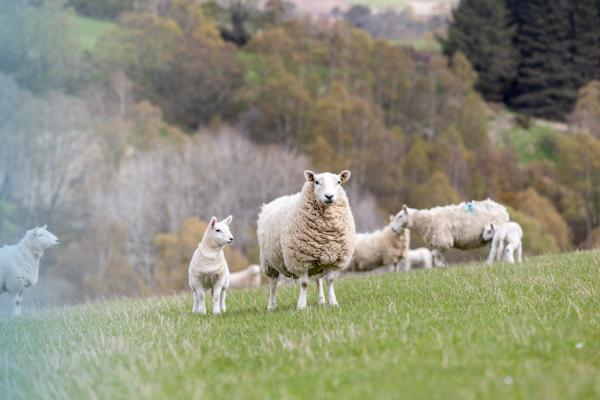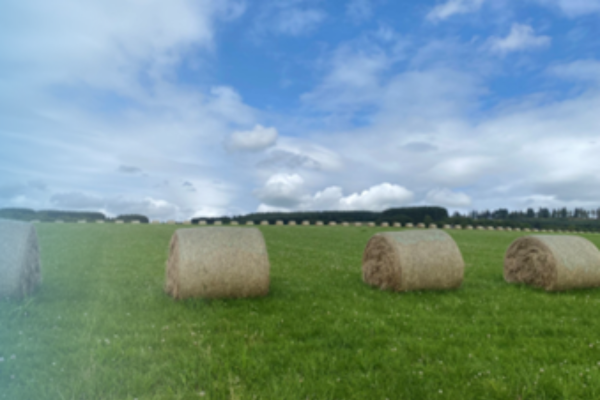Agribusiness News July 2024 – Management Matters: Bluetongue
1 July 2024Update on Bluetongue Virus Serotype 3 (BTV-3)
There is a very high probability of a new introduction of bluetongue virus serotype 3 (BTV-3) in livestock across Great Britian this year. The disease is spread through infected biting midges, with a high risk of them being blown over from badly affected countries in Northern Europe. They can travel long distances, up to 200km by wind. As midges are most active between April and November, we are now in the middle of the risk period. While all ruminant animals including camelids can be affected by the disease, there is no risk to food safety or evidence of the virus infecting humans.
It only takes one bite from an infected midge to transmit the disease and the animal will be infectious 2 to 4 days after being bitten. Another route of infection is for an infected animal to be bitten by an uninfected midge. The virus then replicates in the midge, moving to the salivary glands where it can then affect other livestock that they subsequently bite.
Symptoms
Sheep tend to be more affected by the disease than cattle, with more severe clinical signs and higher mortality rates. Mortality rates in sheep can be as high as 70%, even though only a small percentage may show clinical signs. Symptoms includes changes in appearance to the mucous membranes of the nose and mouth and reddening of the coronary band of the foot, causing lameness. Nasal and eye discharges may be evident, as well as excessive salivation (due to mouth ulcers) and high rectal temperatures. The following table details the common symptoms seen in cattle and sheep/goats:
| Cattle | Sheep/goats |
|---|---|
| Lethargy | Mouth ulcers |
| Poor appetite | Nasal discharge |
| Milk drop | Salivation |
| Fever | Facial swelling |
| Nasal discharge | Swelling of the coronary band |
| Reddening of the coronary band | Lameness |
| Reddening and erosions on the teats | Fever |
| Reddening of the mouth, eyes and nose | Laboured breathing |
| Crusty erosions around the muzzle and nostrils | Subcutaneous haemorrhage (bleeding under the skin) |
Unborn offspring can contract the disease if the dam is infected, causing abortion and foetal deformities similar to Schmallenberg.
Prevention
Prevention is very difficult – there is no evidence that insecticides or repellent products are effective. Airflow in sheds is important as midges cannot fly in high winds. They do not like rain and for the virus to replicate in midges, the average daily temperature has to be higher than 15°C. The risk of infection is therefore perhaps lower when livestock are grazing high, windy and colder fields.
The risk to livestock in GB will be dependent on the extent of the disease in Northern Europe, the timing and extent of an influx of infected midges from Northern Europe, as well as wind patterns and temperatures. However, the greatest risk will be to the south and east coast of England. The disease could also spread via importing infected animals, as well as genetic material e.g. semen and embryos.
Currently there is no vaccine authorised for use against BTV-3 in the UK or Europe, although Dutch authorities have approved a vaccine which has emergency use approval (but not market authorisation).
Farmers should be aware of the clinical signs and be extra vigilant for any of these signs in their livestock. If sourcing animals (or genetic material) from Europe, know the current disease status of exporting countries and collection centres. It is worth asking for a PCR test for Bluetongue before importing animals and ensure that imported animals have the appropriate paperwork and are compliant with the conditions in the export health certificate. All imported, susceptible animals should be housed separately from other animals in the herd or flock during the time they are under restriction.
Further information
As bluetongue is a notifiable disease, any suspected case must be reported ASAP to Animal and Plant Health Agency (APHA). The latest news updates on the virus, along with additional resources with information can be found at:
https://ruminanthw.org.uk/bluetongue-virus/
The following article published in In Practice also contains useful reading on clinical signs and differential diagnoses:
https://bvajournals.onlinelibrary.wiley.com/doi/epdf/10.1136/inpract.30.5.242
Lorna MacPherson, lorna.macpherson@sac.co.uk
Sign up to the FAS newsletter
Receive updates on news, events and publications from Scotland’s Farm Advisory Service


































